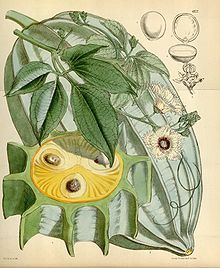Telfairia occidentalis
| Fluted gourd | |
|---|---|
 |
|
|
Telfairia occidentalis, illustrated by Joseph Dalton Hooker, 1877 |
|
| Scientific classification | |
| Kingdom: | Plantae |
| (unranked): | Angiosperms |
| (unranked): | Eudicots |
| (unranked): | Rosids |
| Order: | Cucurbitales |
| Family: | Cucurbitaceae |
| Genus: | Telfairia |
| Species: | T. occidentalis |
| Binomial name | |
|
Telfairia occidentalis Hook.f. |
|
Telfairia occidentalis is a tropical vine grown in West Africa as a leaf vegetable and for its edible seeds. Common names for the plant include fluted gourd, fluted pumpkin, and ugu in the Igbo language. T. occidentalis is a member of the Cucurbitaceae family and is indigenous to southern Nigeria. The fluted gourd grows in many nations of West Africa, but is mainly cultivated in [Igboland|southeastern Nigeria] and it is used primarily in soups and herbal medicines. Although the fruit is inedible, the seeds produced by the gourd are high in protein and fat, and can, therefore, contribute to a well-balanced diet. The plant is a drought-tolerant, dioecious perennial that is usually grown trellised.
T. occidentalis is traditionally used by an estimated 30 to 35 million people indigenous people in Nigeria, including the Efik, Ibibio, and Urhobo. However, it is predominantly used by the Igbo ethnic group, who continue to cultivate the gourd for food sources and traditional medicines. A recurring subject in the Igbo’s folklore, the fluted gourd is noted to have healing properties and was used as a blood tonic, to be administered to the weak or ill. It is endemic to southern Nigeria, and was an asset to international food trades of the Igbo ethnic group.
The fluted gourd fruit is quite large; one study documented a range of 16–105 centimetres (6.3–41.3 in) in length, and an average of 9 cm in diameter. The same study found the seed count in larger gourds to reach upwards of 196 per fruit, typically measuring between 3.4 and 4.9 cm in length. In both the pistillate and staminate varieties, T. occidentalis flowers grow in sets of five, with creamy-white and dark red petals, contrasting with the light green colour of the fruit when young, and yellow when ripe. Dioecious flowering is most common in the fluted gourd, with very few documented cases of monoecious flowering
Considered an “oil seed”, the fluted gourd is high in oil (30%).Shoots of T. occidentalis contain high levels of potassium and iron, while seeds are composed of 27% crude proteins and 53% fats. The leaves contain a high amount of antioxidants and hepatoprotective and antimicrobial properties.
...
Wikipedia
